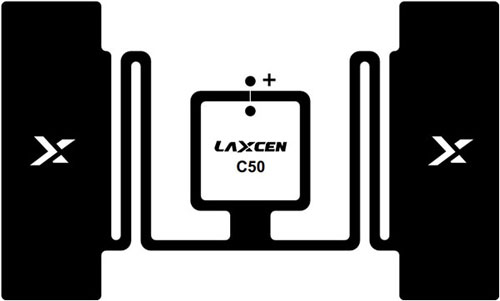Hong Kong tag and label manufacturer Laxcen Inc. has begun marketing its products in the United States, after the company’s C50 and C70 tags, designed for apparel and health-care applications, passed the RFID Research Center’s Arkansas Radio Compliance (ARC) tests a few months ago. Once a radio frequency identification product passes these tests, it is listed as an inlay approved for use on apparel within the United States and Europe.
Since it was founded two decades ago, Laxcen has focused on growth not only in standard ultrahigh-frequency (UHF), high-frequency (HF) and Near Field Communication (NFC) tags, but also in creating specialty tags for unique applications. Two examples are in the wine and automotive sectors. An unnamed Chinese wine brand has adopted a custom-designed Laxcen passive EPC Gen 2 UHF RFID label to authenticate its bottles. The label, which measures 44 millimeters by 38 millimeters (1.7 inches by 1.5 inches), is affixed to a bottle cap’s exterior and serves as a seal when that bottle is closed. If an individual removes the cap, the label’s antenna is destroyed, indicating a potential counterfeit product. In the case of the automotive industry, two car manufacturers—one Japanese, the other German—are applying a specially designed RFID label—measuring 40 millimeters by 18 millimeters (1.6 inches by 0.7 inch)—on certifications of conformity stored with a car’s user manual, in order to track each vehicle’s identification and history.
Laxcen is headquartered in Hong Kong, with its manufacturing site in Ningbo, China. The goal of its founders was to create a company that could meet the growing demand for RFID tags in Asia, as well as globally. They saw not only a growing RFID market, but also an unmet need for specialty tags for specific use cases, such as anti-theft technology and counterfeit detection.
The company partners with the HKUST RFID Center for research and development work. As a result of that collaboration, the company has designed and manufactured a wide range of RFID inlay and tag products to target a variety of unique applications.
Initially, the company’s customers have been in Asia. However, the firm is now expanding to a larger market that includes the United States, and for that reason it obtained certification from the University of Arkansas’ RFID laboratory across all apparel categories for its C50 and C70 tags. Both inlays are made with Impinj‘s Monza 5 chip. The company is now looking for office space in California or elsewhere on the West Coast. “This is our global expansion year,” says Lawrence Lin, Laxcen’s marketing manager. The firm is preparing to open offices not only in the United States, but also in several developing countries, though the specific locations have yet to be decided, he notes.
When it comes to specialty solutions, the Chinese wine company is using the Laxcen labels to ensure the authenticity of every filled bottle. Because counterfeit wine can sometimes turn up in the supply chain, the company wanted a solution that would allow retailers or customers to use a handheld RFID reader to verify that a particular bottle of wine was genuine. Each tag’s ID number is linked to data regarding the wine contained within, as well as when and where it was bottled, and a standard reader can be used to capture that data. If a bottle is counterfeit, the label will either be missing entirely, or it will have been broken when the bottle was opened, thereby rendering it inoperable. “This label serves as authenticity check as well as production info gathering,” Lin explains, since retailers and buyers can also use the label to identify when and where the wine originated, in order to help ensure product quality.
For vehicle identification, the two automotive companies—which have asked to remain unnamed—are applying Laxcen’s custom-designed EPC Gen 2 passive UHF tag to printed owner’s manuals. In both cases, a dealership equipped with an RFID reader can interrogate the tag on the manual of each new car it receives, thereby creating an automatic, electronic record of the types of vehicles available on its lot, along with each car’s features. An individual can access these features much more easily than having to walk to each car and visually read all details listed in the manual, or on the advertisement paperwork pasted to the vehicle’s window, the company reports.
In addition, Laxcen provides RFID tags in large volume to several libraries. One such facility, located at a university in Nanjing, China, is using the company’s standardized LX-L120 UHF tag to track library books and other media. Made with the Monza 5 chip, the LX-L120 measures 120 millimeters by 3 millimeters (4.7 inches by 0.1 inch).
Laxcen also operates a division in China that serves as a systems integrator for its technology. However, the company may expand that division to provide integration in other geographic regions as well.



